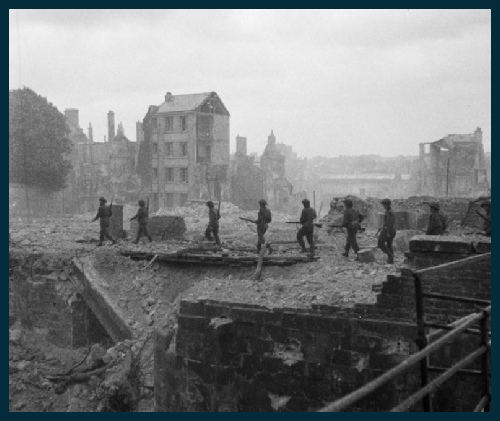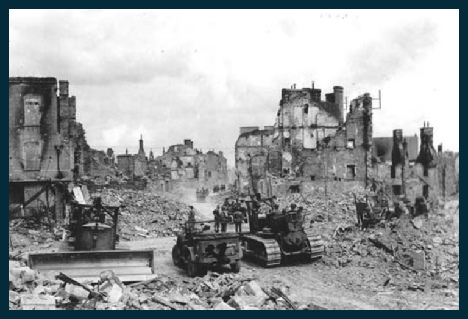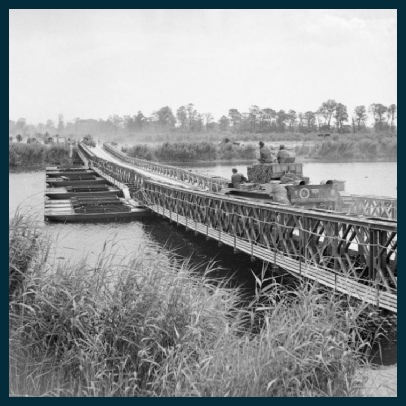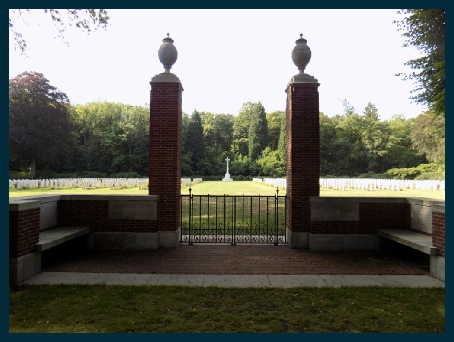Copyright © All rights reserved.



Douglas Crutchley
Douglas Edmund Crutchley was born in the third quarter of 1919 and his birth registered in the Malton area. He was the son of Harry and Maud Ellen (nee Sawdon) Crutchley who married in the Malton area in the first quarter of 1913.
Douglas Crutchley sang in the choir at Old Malton and at the outbreak of WW2 lived on Peasey Hill
The 4th Field Squadron was one of the first new Sapper units raised in the war and accompanied by a Field Park Troop, together with the Headquarters of the "CRE" (Commander Royal Engineers), formed the initial constituents of the Seventh Armoured Division (The Desert Rats) Engineers. They were raised in Britain in April 1940 and it is likely that that is when Douglas joined up. By 1944 he had made Lance Corporal.
The 4th Field Squadron of the Royal Engineers formed part of the 7th Armoured Division. From 1940 to 1943 they were serving in North Africa, before participating in the Invasion of Italy. From there they returned to England at the end of 1943 in order to take part in the D-
The area of Normandy the Division was to start fighting in was the Calvados region, south of the Bay of the Seine. It could be divided into to parts. The open campagne area south and south east of Caen, with rolling fairly open country side and the close bocage area to the south and south west of Bayeux. In 1944 this bocage was a maze of small, high-
By evening Villers-
At first light on 14th June an air attack by rocket firing typhoons swept in to harry the Germans, boosting morale as it did so. As the German advance was exclusively made up of infantry, the tanks were able to wreck havoc with their machine guns, with the Panzer Grenadiers being mown down in ranks as they advanced. Even the battle hardened tank crews were horrified at the slaughter. By now there were reports of enemy activity all around the 'Box' with regular mortar attacks being received and as the day carried on various other attacks were made by the Germans on all sides of the "box". Although the position was in a strategic situation, being relatively easy to defend while inflicting heavy causalities on the attackers the British high command decided that the Division should withdraw to straighten the front line, as 50th Division were unable to make much progress in the Tilly area. Early in the evening the order for the withdrawal to commence at 23:15 hours was being passed down to all the units, just as a German attack began. This took the form of two Panzer Grenadier battalions, supported by some tanks to the south with small company size units on either side of the main force to prevent reinforcements being moved in to the area of the main attack. This attack nearly reached Brigade HQ before being repulsed and the Germans had suffered badly with up to 20 tanks and hundreds of dead or wounded Panzer Grenadiers lying in or around the Brigade Box. At 00:30 hours, the exhausted Brigade, having been in almost constant action for the last three days, began to pull out. This was covered by an RAF bombing raid on Aunay-
On 30th June the Division withdrew to an area near Jerusalem to a rest and re-
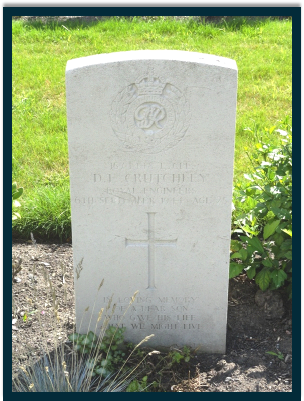
At dawn on 5th September, 11th Hussars and the Inniskilling Dragoon Guards entered the city from the east. They fought of attacks by roving groups of retreating Germans. In spite of some opposition from snipers and pockets on infantry by 20:00 that day the bulk of the Division had entered Ghent and its tanks were parked outside the Town Hall. During the next three days the city and surrounding areas were cleared of any pockets of resistance and the Division prepared for a counter-
Presumably it was here that Douglas died on 6th September 1944 and was buried in Oombergen, Belgium. In 1946 his body was exhumed and reburied in Leopoldsburg War Cemetery in North East Belgium.
There are about 35 original burials in Leopoldsburg War Cemetery associated with isolated engagements in or near the town in May 1940. Of the remainder, some are burials from a military hospital which was established at Leopoldsburg during the latter part of 1944 and others were brought into the cemetery from the surrounding district.
Ahead of them lay the process of liberating the rest of Europe, starting with Belgium, with the cities of Antwerp, Brussels and Ghent, and Ghent was the responsibility of 7th Armoured Division. The advance began on 31st August in pouring rain and with only two bridges over which to cross traffic congestion immediately caused problems. However, once the Division was across the river, the speed of advance quickened and they reached the Somme on the 31st, only meeting scattered pockets of resistance on the way.
The crossing of the Somme proved very difficult as all the bridges in the Divisions area had been blown up, except for one at Hangest, which then collapsed as the first Squadron of the Scots Greys tried to cross it. The Royals and 44th RTR of 4th Armoured Brigade did get across near Amiens and a Bailey bridge was flung across by 4th Field Squadron RE, near Picquigney, five miles to the west. The advance then continued to the next river obstacle the Authie, where stiffening resistance was met from German companies and battalions. By now the Division was so far ahead of Corps HQ, it had lost radio contact and 7th Armoured had advanced so far that it was off the edge of its maps, but still it moved onwards, quite often during the night. Its aim was to move so fast, it could get to the next enemy strongpoint and pounce on it before the Germans were ready. On 4th September, the Division was ordered to make a final dash across the Franco-
During the second week of August, the Allied Armies managed to pin the German forces into an area known as the Falaise Pocket which became a mass of burning tanks and vehicles, dead and injured men and since the Germans still used horse transport, hundreds of dead horses. The Division advanced on 17th August. The Luftwaffe was still active at night, but on the 18th the River Vie was crossed near Livarot, with the town being captured on the 20th.The engineers were greeted by the townsfolk waving flowers and bottles of wine. The bridge over the Vie was strengthened to allow the 22nd Armoured Brigade to cross that afternoon and they were soon advancing on the road to Lisieux, towards the River Touques. There a bridge was found intact and on 21st August the advance continued, despite small groups of German troops and tanks attacking periodically, plus the normal hazards from mines and booby-
Having tried twice to attack Caen from the west, Montgomery decided the next assault would be on the east of the city. This was to be called Operation Goodwood and was to start on 18th July 1944. The plan was for the 11th Armoured, the Guards Armoured and 7th Armoured Divisions to move across the Orne river and increase the size of the bridgehead on the far bank, plus to engage and destroy as much of the German armour as possible. The British would then advance onto Falaise. The Division moved up from Jerusalem to positions north and north west of Caen on 17th July before moving across the Orne river bridges on 18th July and they took the town on 20th July. The weather then broke and torrential rain turn the ground to mud, so the Division concentrated near Demouville. Thus 'Operation Goodwood' ground to a halt in the mud. However, the attacks had drawn much of the German forces away from the American front -
They next took part in Operation Spring, in lateJuly, in support of the 2nd Canadian Corps, as a combined infantry and tank assault down the main Caen-
